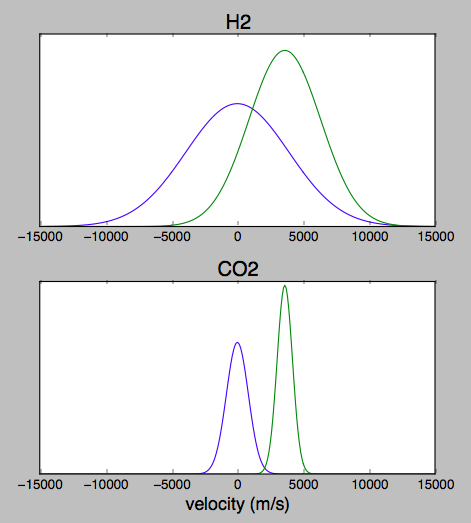@RussellBorogove's answer mentions temperatures of roughly 3700 K and 1800 K in the combustion chamber and exhaust of a big rocket engine.
The canonical Wikipedia plot of velocity and temperature for a de Laval nozzle is shown below as a schematic representation only.
Ignoring some aspects of gas theory, we can estimate the thermal velocity of a molecule using
$$v_T = \sqrt{\frac{k_\mathrm B T}{m}}.$$
Testing example using air or nitrogen ($m=28 \times 1.673\times10^{-27}\ \mathrm{kg}$) at $293\ \mathrm K$ with Boltzmann constant $k_\mathrm B = 1.381\times 10^{-23}\ \mathrm{J/K}$ gives $297\ \mathrm{m/s}$ which does agree with the speed of sound (a good rough indicator of average thermal velocity).
species mass (kg) 293 K 1800 K 3700 K
------- --------- ------ ------ ------
H2 3.346E-27 1100 2700 3900
CO2 7.361E-26 230 580 830
The thermal velocity will be isotropic (all directions) but the exhaust velocity is directed mostly in one direction.
The Maxwell-Boltzman distribution projected in one dimension is given as
$$f(v)\,\mathrm dv = \left( \frac{m}{2 \pi k_\mathrm B T}\right)^{1/2} \exp\left(-\frac{mv^2}{2 k_\mathrm B T}\right)\,\mathrm dv$$
The directed exhaust velocity might be close to zero in the combustion chamber, and roughly $3600\ \mathrm{m/s}$ in the nozzle.
Assuming that the engine burns methane and a little bit of H2 is formed in the exhaust in order to fulfill the terms of the question, this plot shows the resulting estimated velocity distributions. For each species, the wide curve centered at zero represents the condition in the combustion chamber, and the narrower curve offset to the right represents the axial velocity exiting the nozzle.
The transverse velocity distribution would look similar except that the the offset for the exhaust curve would be closer to zero and depend on distance from the axis and details of under/over expansion. That's a more complicated calculation and has too many special cases for to address for this level of approximation.

def f(v, v0, m, T):
term_1 = np.sqrt((m)/(twopi * kB * T))
term_2 = (m * (v-v0)**2)/(2*kB*T)
return term_1 * np.exp(-term_2)
import numpy as np
import matplotlib.pyplot as plt
twopi = 2 * np.pi
kB = 1.381E-23
mp = 1.673E-27
temps = np.array([3700, 1800])
v0s = np.array([0, 3600])
m_H2, m_CO2 = mp * np.array([2, 44])
v = np.linspace(-15000, 15000, 301)
f_H2 = [f(v, v0, m_H2, T) for (T, v0) in zip(temps, v0s)]
f_CO2 = [f(v, v0, m_CO2, T) for (T, v0) in zip(temps, v0s)]
if True:
fig = plt.figure()
for i, (f, name) in enumerate(zip((f_H2, f_CO2), ('H2', 'CO2'))):
ax = fig.add_subplot(2, 1, i+1)
# plt.subplot(2, 1, i+1)
for thing in f:
ax.plot(v, thing)
ax.set_title(name, fontsize=18)
# ax.set_yticklabels([]) # no labels
plt.gca().axes.get_yaxis().set_visible(False) # no labels or ticks
ax.set_xlabel('velocity (m/s)', fontsize=16)
plt.show()
 Source
Source


